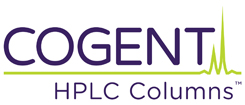There are many differences between the columns used for HILIC and Cogent TYPE-C™ columns but for the sake of brevity, we will only address some of the differences.
Similarity: The Cogent TYPE-C (Silica Hydride) HPLC Columns perform similarly to HILIC columns in as far as polar compound elution order is concerned (when using higher than 70% organic composition of the mobile phase) and both columns perform separations that are thought to be based on variations of normal phase chromatography with one being called “HILIC” and the other called “Aqueous Normal Phase” (ANP). HILIC columns will retain polar compounds that cannot be retained by reversed phase columns and so will the Cogent columns.
Differences: a HILIC stationary phase is more polar than the TYPE-C™ phases which are relatively non polar. The HILIC columns will not retain non-polar compounds while one of the biggest advantages of the Cogent columns is the ability to separate polar and many non-polar compounds sometimes in the same isocratic or gradient run.
With HILIC columns, polar compounds partition into and out of the Hydration Shell created by adsorbed water on the silica surface (see below). As the aprotic solvent such as acetonitrile concentration increases the water layer decreases and the charged polar analytes become retained by the combination of cation exchange with the silanols under the water layer and the partitioning effect. The combination of these two mechanisms retains polar compounds in HILIC mode. For reproducibility, this water shell thickness and salt content must be managed by the chromatographer between gradient runs by careful equilibration.
On Cogent TYPE-C Columns, the polar compounds elute in a similar order as on HILIC columns as stated above; however non-polar compounds may be retained at the same time by the non polar phase of the Cogent columns which could have a small hydrocarbon bonded phase on a silica hydride surface. Since there are virtually no silanols to speak of on these columns, the polar compounds are retained more by the adsorptive character of the silica-hydride. Because of the lack of an effective Hydration Shell at high organic content due the weak association with water of the Cogent columns (see below), the phase will equilibrate and change more rapidly with all silica hydride based columns than with HILIC columns. This is an advantage when rapid gradients are desired.
HILIC columns are intended to only perform HILIC while Cogent TYPE-C columns can perform ANP, Reversed Phase and traditional Normal Phase using completely non-polar solvents such as hexane. There is no hysteresis when changing between these modes making this column extremely efficient. There are other features and benefits of these unique columns and they are addressed in other Knowledge Base articles.

HILIC Phases have a Water Shell Cogent TYPE-C Silica has no Water Shell
See also: Comparison of the efficiency in ANP vs. HILIC.
See also: Wikipedia definition of ANP
See also: ANP v. HILIC Advantages
A very popular journal article on this subject:
Journal of Chromatography A, E. Barto, A. Felinger & P. Jandera Investigation of the temperature dependence of water adsorption on silica-based stationary phases in hydrophilic interaction liquid chromatography, 2017, Volume 1489 pages 143-149


